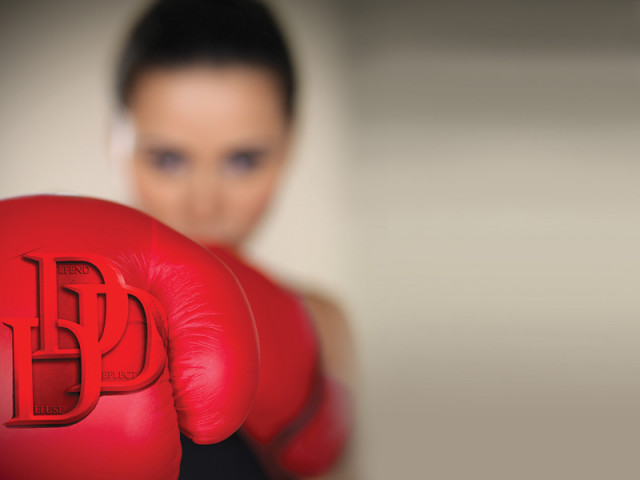The 3D’s of self-defence
In these troubled times, you need to know how to Defend yourself, Deflect attacks, and Defuse dangerous situations.

In these troubled times, you need to know how to Defend yourself, Deflect attacks, and Defuse dangerous situations.
“This is how we disarm,” he says as he puts away the unloaded revolver and casts his eye on his other students as they mill about this makeshift training center.
Clad in a bright Jui Jitsu uniform, 42-year-old self-defence instructor Gohar Gul is clearly a hard taskmaster, surveying his trainee fighters with a steely gaze as they prepare their ‘fighting stance’ — knees bent and fists raised high. It is half an hour into the session; they have run 4km outside the training centre, have flipped tires weighing 90kg-95 kg, and are now ready to fight. “The first rule of self-defence is that there are no rules,” Gul’s confident voice echoes loudly.
Suddenly a voice chimes in from the back of the studio room, and there are sounds of scattered laughter. The palpable tension has dissolved with a joke. “Oye, fighter. Serious ho!” exclaims Gul, his otherwise tough expression relaxing into a smile. In this class of twelve, the eldest is twenty-three, and the youngest, a girl, is seventeen.
With the fighters duly disciplined, Gul turns his attention towards me once again with a reassurance that the exercise need not be repeated again. The disarming technique he so painfully demonstrated is only taught to select clients who train with him personally. My sigh of relief slightly dulls the sharp pain that is still searing through my arm when, next, he orders me to kick him with full force. At last, I comply only to find my foot striking what feels like solid rock. This now unflinching muscular frame is the product of many hardships endured on the ground, and 32 years of apprenticeship in martial arts.
“I started from the footpath,” Gul begins his story. “I ran away from my village after my parents were killed, and I had no family or shelter. I roamed from one city to another in search of a home for years, subjected to abuse, fighting many battles for survival.” He points at his students: “You see, these people come here to train, but for me, my whole life was a test of self-defence.”
At the age of ten, Gul’s life took a turn similar to that of Daniel’s in the famed movie Karate Kid. He encountered his own Mr Miyagi by chance while practicing at the ‘Khadda Ground’ in Islamabad, then an empty plot of land. Approaching the martial arts instructor, he asked about joining the classes being held in the ground. “I began to cry when he told me about the fee because I could not afford them,” Gul recalls, “but he finally agreed to take me under his wing. Within a month’s time, I became his favourite student.”
“Teaching martial arts is not just a job, but a duty.”
For many Pakistanis, conflict and crime are part of their daily lives, whether in the biggest of cities or the smallest of chaks. Stories of street crime at the nearest street or traffic signal are reiterated over drawing room conversations, with only slight variations. The only solution, Gul says, is to be prepared for the worst. To him, teaching martial arts is not just a job, but a duty.
For this reason, he gives free classes at Amir Khusro road to all those who cannot afford the cost of his regular classes. “Everyone should know the skill, and not just the elite of the country,” he says.
On a number of occasions, he has used this art to defend himself against street crime and to ward off aggressors. “When you are in a conflict situation, you only have a few seconds to utilise your skills. Otherwise your mastery over martial arts is useless,” he says. “Last year, my wife and I were approached by two mobile snatchers. It was a sensitive time because my wife was in her last stages of pregnancy. When the man took out his gun, I acted within seconds. I was slightly injured, but my mission was accomplished; I managed to disarm him.” Gul explains that there are 45 vulnerable points in the body that can be targeted. The combat style one chooses to adopt depends on the situation: Jiu Jitsu is best for one-on-one combat, whereas Muay Thai is preferred when faced with two or more opponents.
I wonder out loud whether knowing these techniques will incline you to get into fights more easily, and whether it would be safer to simply comply with would-be robbers. “I don’t think so,’ Gul says, shaking his head. “Unless you take a stand against something, you will never be able to put an end to it. If each person complies with the criminals, then that is a green signal for them to continue their activities.”
But fists, no matter how quick and well-trained, are no match for firearms and one must gauge the danger in a situation before making a move. “It is about knowing when to act, and keeping your mind in control. You cannot fight back if you throw yourself in an emotional rage.”
One of Gul’s students, 21-year-old Usman Shah also says that one must have the skill to defend oneself, regardless of whether you choose to use it. “You can either invite trouble by defending yourself, or get you’re a** kicked by not doing so,” he says in a matter of fact tone. But he recognises the uses and abuses of this art. “Whether the skill is used as a defensive or an offensive measure depends purely on the person. There could be someone who would only want to show off, or another, genuinely humble person, who would only try to protect and defend himself.”
Usman’s fellow student, Tariq Ali, agrees: “There are times when you have to back down, and other times when you have to push forward.” Another 20-year-old student, Shayaan Paracha recalls using his skills to overcome two muggers who approached him when his car broke down. “Luckily, they were unarmed,” he says. Although he managed to chase them away, he cautions: “You should never think that you won’t get hurt, because you are taking a risk in the end.”
While no one would endorse the idea of taking on armed robbers, nowhere is the need for martial arts more acutely felt than in cases of street harassment or sexual assault. In recent years, more and more women are flocking to self-defence classes, throwing all convention to the winds. Many are even encouraged that similar workshops are now being held for young women after the infamous gang rape in New Delhi. Training in this art not only keeps them fit, but also gives them a sense of empowerment.
17-year-old Ladain is the youngest martial arts student in her class. Her parents were not enthusiastic about her training, but she was driven by her passion. “I think it is important, especially as a girl,” she says. “When I train, I feel at par with my male colleagues. I may not be on their level physically, but mentally I am.” But despite the obvious confidence martial arts training has given her, she knows where to draw the line. “This doesn’t mean I’m going to act like a hero or a superman if someone approaches me with a gun.”
Those days are long gone when thefts took place only in unlit alleys in the middle of the night. Much of street crime today happens just as much in broad daylight on a busy street. Riding on motorbikes, armed muggers are able to stop vehicles at gun point, as by-standers watch, either too scared or too late to intervene. Often police officers also shrug themselves off such incidents. In a country where shotguns and fake firearm licenses proliferate, one is faced with a very formidable opponent indeed.
“I think of how I would mug me”
For Naveed Khan, founder of the security consultancy Aftershock-CEM, self-defence goes well beyond simply learning martial arts. It’s based on being proactive, taking precautions and learning lessons. “It is a rule of thumb, and not just in Pakistan, that when you are getting mugged, always comply; never resist,” he says. Lamenting the ‘glorified’ culture of guns and guards in Pakistan, Khan advises that people should learn to not put themselves in a compromised situation. “I think of how I would mug me,” says Khan, as he gives a list of precautions to keep you out of trouble. These include discovering alternative routes with lesser stops on the road, avoiding deserted banks and ATMs, keeping a spare phone, a duplicate NIC and a list of important numbers in case of emergency. “You would be surprised how many people don’t know the most important numbers — fire or ambulance,” he says.
And then, there is the oft-neglected question of training in basic first aid and CPR. “In a survey of 500 people, only 7% knew about first aid and CPR,” he says. Equally important for Khan are crowd management and conflict resolution skills through which a volatile situation can be neutralised. When threatened with mob violence, martial arts training may be rendered moot, but Khan believes that there is another way out. “There is always one person who will either make it worse for you or help you get away. Learn to control that one person. Have a loud, confident but polite tone, and never look down. Tell them that you are there to talk” he says. “Your tongue and your brain are much better weapons than any gun or fighting style you can learn.”
While such an approach to self-defence may appear quite against the grain in Pakistan, it worked for Rauf Ali*, a security officer who had trained with Aftershock on conflict management. When his car crashed with another in D.H.A Phase IV, tempers began to flare and an angry crowd began to gather. At this point, Ali made a grand show of taking the gun he was carrying, and putting it back in his car — visibly out of his reach. This was his tactic to earn the crowd’s trust, to show that he was there to talk and not to fight. Were it not for his composure and his presence of mind, the situation could have turned explosive any moment.
In this more holistic approach to self-defence, hand to hand combat is absolutely the last resort. “[Use it] only when you have no other option whatsoever, or when you have already been hit and it is about to get worse,” is what Khan advocates. To this end, Khan does teach the use of certain self-defence methods geared towards protecting yourself from the advances of the aggressor.
As the security situation continues to worsen in Pakistan, ordinary citizens feel that they are pretty much on their own, the only options being to either sit back helplessly or to learn how to protect themselves. When it comes to the latter, learning self-defence techniques isn’t just a way to impose order on the chaos that surrounds them, but could also make the crucial difference in a life or death situation.
“We need to start thinking more proactively about our security,” says Khan. “So learn a skill and be prepared.”
*some names have been changed to protect anonymity
Published in The Express Tribune, Sunday Magazine, March 17th, 2013.
Like Express Tribune Magazine on Facebook to stay informed and join the conversation.


















COMMENTS
Comments are moderated and generally will be posted if they are on-topic and not abusive.
For more information, please see our Comments FAQ